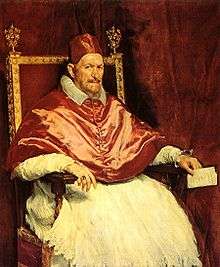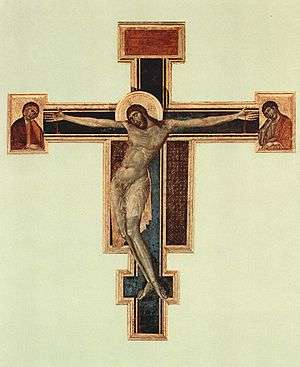Influences on Francis Bacon

Portrait of Pope Innocent X, 1650, by Diego Velázquez

Cimabue's Crucifix (1287–88) was a recurring influence on much of Bacon's mid-1940s and early 1960s work
.jpg)
Woman walking downstairs, by Eadweard Muybridge
The painter Francis Bacon was largely self-taught as an artist. As well as other visual artists, Bacon drew inspiration from the poems of T. S. Eliot,[1] Ezra Pound and Yeats, the plays of Aeschylus, Sophocles and Shakespeare; Proust and the Joyce's Ulysses.
Influences
- Pablo Picasso, in particular the biomorphic figures in Picasso's paintings of bathers at Dinard of 1927–32.[2]
- Diego Velázquez's portrait of Pope Innocent X (1649–50). "that Velázquez is one of the great paintings of the world, of course – well, I was very obsessed with that Velázquez and, of course, I made a great mistake…". Bacon painted several versions, of which Figure with Meat (1954) is an atypically Grand Guignol example. Though he visited Rome, where the painting is on display at the Doria Pamphilj Gallery, Bacon never saw the original Velázquez.[3]
- Vincent van Gogh; Bacon painted several variations of van Gogh's The Painter on the Road to Tarascon in the late 1950s.[4]
- Rembrandt Self-portrait (Musée Granet, Aix-en-Provence)[5]
- Chaim Soutine Céret period (1919–1923), Carcass of Beef (1926) (Minneapolis)[6]
- John Constable – the full size oil-sketch for The Leaping Horse at the V&A.
- Titian Portrait of Cardinal Filippo Archinto (c.1551–1562)
- Francisco Goya's Black Paintings, although Bacon saw a meanness of spirit in Goya's work that he believed removed him from the front rank of great painters.
- Michelangelo's drawings
- Henri Matisse's Bathers by a River (1909–16)[7]
- Pharonic Egyptian sculpture of the Eighteenth dynasty, from the rule of Amenophis III and Amenophis IV especially.
- Masaccio Trinity c.1424–1428 Santa Maria Novella—Bacon greatly admired Masaccio and similarities between the composition of Trinity and Painting (1946) have been noted by critics.
- Jean Auguste Dominique Ingres Oedipus and the Sphinx (1826–1827), Le Bain Turc (1859–1863)
- Edgar Degas After the Bath, Woman drying herself (1888–1892), Beach Scene (1868–1877)—Both in the collection of the National Gallery, London
- Walter Sickert Granby Street (1912–1913)
- Henri Michaux Untitled (1962)
- Pierre Bonnard
- Georges-Pierre Seurat
- Cimabue "You know the great Cimabue Crucifixion? I always think of that as an image – as a worm crawling down the cross."[8]
- Alberto Giacometti's drawings[9]
- Matthias Grünewald's Isenheim Altarpiece[10]
- Julia Margaret Cameron
- Étienne-Jules Marey
- Eadweard Muybridge[11] "My principal source of visual information is Muybridge, the 19th-century photographer who photographed human and animal movement. His work is unbelievably precise. He created a visual dictionary of movement, a living dictionary."
- Nadar
- John Deakin. Regular at the Colony Room Club and noted photographer who took portraits of Bacons friends on which many of his 1960s paintings were based.[12]
- Luis Buñuel. "I've been very influenced by the films of Buñuel, especially Un chien andalou because I think that Buñuel had a remarkable precision of imagery. I can't say how they have directly affected me but they certainly have affected my whole attitude to visual things – in the acuteness of the visual image which you've got to make."
- Sergei Eisenstein. Strike (Стачка, 1925) and The Battleship Potemkin (Броненосец „Потёмкин“, 1925). Often reproduced the scream of the nurce from the Odessa Steps scene.[1]
Notes
- 1 2 Zweite, Armin (ed) (2006). The Violence of the Real. London: Thames and Hudson. 93 ISBN 0-500-09335-0
- ↑ Sylvester, David (2000). Looking back at Francis Bacon. London: Thames and Hudson. 19. ISBN 0-500-01994-0
- ↑ Schmied, Wieland. Francis Bacon: Commitment and Conflict. Munich: Prestel, 1996. 17. ISBN 3-7913-1664-8
- ↑ Francis Bacon Estate, retrieved 28 June 2009
- ↑ "Francis Bacon Self-Portrait Study Leads Christie's NY Post-War & Contemporary Art Sale". Art Knowledge News, November 2008. Retrieved on 1 July 2009
- ↑ Deleuze, Gilles. Francis Bacon: The Logic of Sensation. Continuum International Publishing Group, 2005. 18. ISBN 0-8264-7930-8
- ↑ David Sylvester has convincingly argued in his essay Bacon and Matisse (1996) [revised as Bacon IV in About Modern Art] for Matisse's pervasive influence on Bacon's painting.
- ↑ Richardson, John. "Tragedian". New York Review of Books, Volume 4, Number 4. 25 March 1965. Retrieved on 1 July 2009.
- ↑ Lord, James. Giacometti . Farrar Straus, 1997. 452. ISBN 0-374-52525-0
- ↑ Sylvester, David (1987). The Brutality of Fact: Interviews With Francis Bacon. London: Thames and Hudson. 46. ISBN 0-500-27475-4
- ↑ Prodger, Phillip. Time Stands Still: Muybridge and the Instantaneous Photography Movement. Oxford University Press, 2003. 263. ISBN 0-19-514964-5
- ↑ Peppiatt, Michael (1996). Francis Bacon: Anatomy of an Enigma. London: Weidenfeld & Nicolson ISBN 0-297-81616-0
External links
Select work
- Chaim Soutine Carcass of Beef (1926) (The Minneapolis Institute of Arts)
- Degas, Hilaire-Germain-Edgar Beach Scene (1868–77) (NG London)
- Degas After the Bath, Woman drying herself (1888–1892) (NG London)
- Rembrandt Self-portrait (Musée Granet, Aix-en-Provence)
This article is issued from Wikipedia - version of the 8/22/2016. The text is available under the Creative Commons Attribution/Share Alike but additional terms may apply for the media files.
